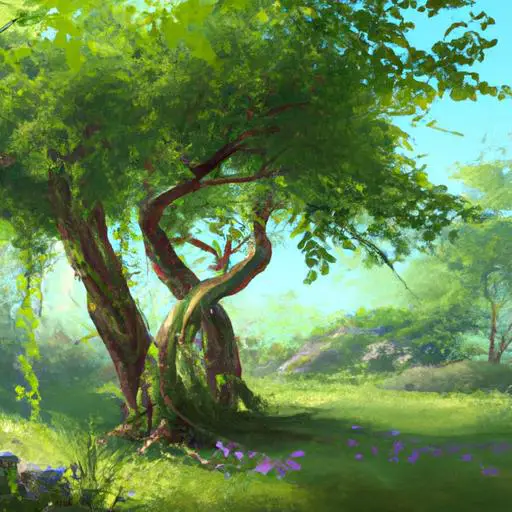Have you ever been walking in the woods and noticed a beautiful tree with leaves that look like theyve been cut with a saw? This is likely an ash tree.
Ash trees are known for their distinctively serrated leaves.
But what other characteristics do ash tree leaves have? In this article, well discuss everything you need to know about ash tree leaves, from their serration to their size and color.
Youll learn how to identify ash tree leaves and the benefits of having them in your landscape.
So if youre curious about ash tree leaves, read on to learn more!
Table of Contents
Short Answer
Yes, ash tree leaves are serrated.
They are typically pinnately compound leaves, meaning each leaf is composed of several leaflets that are arranged along a central stem.
These leaflets have saw-toothed edges and are generally oval in shape.
Ash tree leaves are usually a medium to dark green color on the top and a lighter green on the underside.
Overview of Ash Tree Leaves
Ash tree leaves have a distinct appearance that sets them apart from other trees.
They are characterized by their serrated, jagged edges, which gives them a unique look that can be seen with the naked eye.
The serrations are usually more prominent on younger leaves, and they are typically oval or lanceolate in shape.
The upper surface of ash tree leaves is glossy, and they typically have five to nine leaflets.
In addition to their serrated edges, ash tree leaves also have a smooth texture and are usually dark green in color.
They are also known for their long petioles, or leaf stems, which attach to the branch of the tree.
The leaves are typically broad, and their undersides are usually lighter in color than their uppersides.
Serration of Ash Tree Leaves

When it comes to ash tree leaves, serration is a highly noticeable feature.
Serration is the jagged or toothed edges that can be seen with the naked eye.
This feature makes ash tree leaves easily identifiable, and it is more pronounced on younger leaves.
The serration of an ash tree leaf is usually paired with an oval or lanceolate shape, and its glossy upper surface is also a tell-tale sign that it is an ash tree leaf.
Ash tree leaves typically have five to nine leaflets, and you can count them to determine if it is an ash tree leaf.
The serration of ash tree leaves is not just a distinguishing feature, however.
It also serves an important purpose in the tree’s ability to photosynthesize and absorb nutrients.
The serrations on the leaves provide a larger surface area for the tree to absorb sunlight and nutrients.
This also helps the tree to stay cool in hot weather and retain moisture in dry weather.
Additionally, the serrations can help the leaves trap and hold air, which is important for photosynthesis.
The serration of ash tree leaves also serves a protective function.
The jagged edges of the leaves act as a natural defense against predators, such as insects and birds.
The serrations can make it difficult for predators to access the nutrients in the leaves, and they also make the leaves less palatable.
This helps the tree to protect itself from damage caused by predators.
In summary, the serration of ash tree leaves is an important feature that can help you identify the tree and understand its role in the environment.
The jagged edges of ash tree leaves provide a larger surface area for the tree to photosynthesize and absorb nutrients, and they also serve as a natural defense against predators.
So, the next time you see an ash tree, take a closer look and appreciate its unique serration.
Characteristics of Ash Tree Leaves
Ash tree leaves are easily recognizable due to their serrated edges, which are jagged or toothed.
These serrations are more pronounced on younger leaves, making them easier to identify.
Additionally, these leaves are usually oval or lanceolate in shape and have a glossy upper surface.
They generally have five to nine leaflets, which can also be identified by their serrated edges.
The serrations of ash tree leaves can be seen with the naked eye, and they are usually more prominent on newly-formed leaves.
This is because the serrations are caused by the leaf’s veins not extending all the way to the leaf margin.
As the leaves age, the serrations fade as the veins extend further.
Ash tree leaves are also known for their glossy upper surface, which is caused by the presence of tiny, waxy droplets.
This glossy surface helps to protect the leaves from water loss, and it also makes them attractive to look at.
Additionally, the undersides of ash tree leaves are usually a lighter color than the tops, and they are often covered in small hairs.
The color of ash tree leaves can also vary, depending on the species.
Some species of ash tree have yellow-green leaves, while others have dark green or even purple-tinged leaves.
The shapes of the leaves can also vary, with some being more elliptical than others.
Overall, ash tree leaves are easily identifiable due to their serrated edges, glossy upper surface, and range of colors and shapes.
While the serrations may fade with age, they are still a useful tool for identifying these trees.
How to Identify Ash Tree Leaves

When it comes to identifying ash tree leaves, the most obvious feature to look for is their serrated or toothed edges.
These edges can be seen with the naked eye, and they are usually more pronounced on younger leaves.
The leaves of an ash tree typically have an oval or lanceolate shape with a glossy upper surface.
Furthermore, ash tree leaves usually have five to nine leaflets.
In addition to the serrated edges of ash tree leaves, there are a few other distinguishing characteristics to look for.
For example, the petioles of ash tree leaves are usually quite short, and they tend to be lighter in color than the leaflets themselves.
Ash tree leaves also have a distinct V-shaped notch at the base of each leaflet.
The veins of ash tree leaves are usually arranged in a palmate or fan-shaped pattern that radiates out from the base of the leaf.
Finally, ash tree leaves typically have a smooth or slightly rough texture.
The color of the leaves can vary from yellowish-green to deep green, and they tend to turn yellow or brown in the fall.
All of these characteristics are important when it comes to identifying ash tree leaves.
Ash Tree Leaf Color
When it comes to the color of ash tree leaves, they can vary depending on the species.
For example, white ash tree leaves are typically a bright, light green color while green ash tree leaves are a darker, bluish-green.
Depending on the season, ash tree leaves can also turn yellow, orange, or even a deep red or purple.
The leaves of the white ash tree are also known to have purple veins running through them, giving them a unique look.
Additionally, the leaves of the green ash tree are often slightly hairy on the underside.
As the season progresses, the color of ash tree leaves will gradually change, becoming more vibrant in the spring and fading to a dull yellow or brown in the fall.
Ash Tree Leaf Size

When it comes to ash tree leaves, size matters.
Depending on the species of ash tree, the size of the leaves can vary greatly.
Generally speaking, ash tree leaves can range from 2-12 inches in length, and they are typically lanceolate or oval in shape.
They can also have anywhere from five to nine leaflets, and the serrated edges are usually more pronounced on younger leaves.
The upper surfaces of ash tree leaves are often glossy, giving them a beautiful sheen when the light hits them.
In addition to size, ash tree leaves also come in a variety of colors, ranging from bright green to deep purple.
The color of the leaves can change with the seasons, and they may even take on a reddish hue as the temperatures drop in autumn.
The leaves can also be a great source of food for birds and small mammals, providing them with nourishment during the winter months.
Of course, the size and color of ash tree leaves isnt the only thing you should be aware of.
Ash trees are also known for their strong wood and attractive bark, which can range from light gray to dark brown.
The wood of ash trees is strong and durable, making it a popular choice for furniture, flooring, and other projects.
Plus, ash trees are also known for their resistance to pests and diseases, making them a great choice for any outdoor space.
Benefits of Ash Tree Leaves
When it comes to trees, ash trees are some of the most beloved.
Not only do they provide shade and a natural habitat for wildlife, but they are also known for their beautiful leaves.
One of the most distinguishing features of ash tree leaves are the serrated edges.
By understanding why ash tree leaves are serrated, you can better appreciate the many benefits that these leaves provide.
The serrated edges of ash tree leaves serve many important functions.
The jagged edges help to protect the leaves from predators such as insects, which can chew away at the edges of the leaves and destroy them.
The serrated edges also help the leaves to channel water away from the leaves, preventing them from becoming soggy and heavy.
The serrations also help to trap air around the leaves, creating a protective layer that helps to keep the leaves healthy.
In addition to their protective qualities, the serrations of ash tree leaves can also be aesthetically pleasing.
The jagged edges create a unique texture that makes them stand out from other trees.
The leaves also have a glossy upper surface, making them particularly eye-catching.
The leaves themselves are usually oval or lanceolate in shape, and they typically have five to nine leaflets.
The serrated edges of ash tree leaves also provide nutritional benefits.
The edges of the leaves are rich in minerals and vitamins, and they can be eaten raw or cooked.
The leaves are also a great source of fiber, which can help to maintain a healthy digestive system.
By understanding why ash tree leaves are serrated, you can better appreciate the many benefits that they provide.
The jagged edges create a unique texture that makes them stand out, and they help to protect the leaves from predators.
The serrations also help to channel water away from the leaves and trap air around them, keeping the leaves healthy.
Finally, the edges of the leaves are rich in minerals and vitamins, making them a great source of nutrition.
Final Thoughts
In conclusion, ash tree leaves are easily identifiable by their serrated edges and glossy upper surface.
They usually have five to nine leaflets and can range in color from green to yellow.
Knowing the characteristics of ash tree leaves can help you differentiate them from other types of trees, so be sure to take a closer look next time youre out in nature.
With the knowledge of ash tree leaves, you can appreciate their beauty and the benefits they bring to the environment.


